Freddie Mac and Fannie Mae each reported strong third quarter financial results today. For Freddie it was the eighth consecutive profitable quarter and for Fannie Mae the seventh. With the dividend payments to Treasury, Fannie will have returned more than 97% of taxpayer, and Freddie will eclipse their draw amount by a fraction of a percent.
Freddie Mac's pretax income, the second largest in the company's history, was $6.5 billion and its net income was $30.5 billion compared to pretax income of $4.9 billion in the second quarter and net income of $5.0 billion. The increase in net income was almost totally due to the $23.9 billion impact of released valuation allowance on deferred tax assets. Comprehensive income was $30.4 billion compared to 4.4 billion the previous quarter.
Under the revised Senior Preferred Stock Agreement the company has a dividend obligation to the U.S. Treasury of $30.4 billion. The agreement requires both Freddie Mac and Fannie Mae to pass through all of their net income less a retained buffer which will diminish over time. This quarter's dividend will bring the aggregate paid to Treasury since Freddie Mac was put into conservatorship to $71.345 billion. The company received draws of $71.336 billion, and Treasury's holdings of senior preferred stock remain at that level.
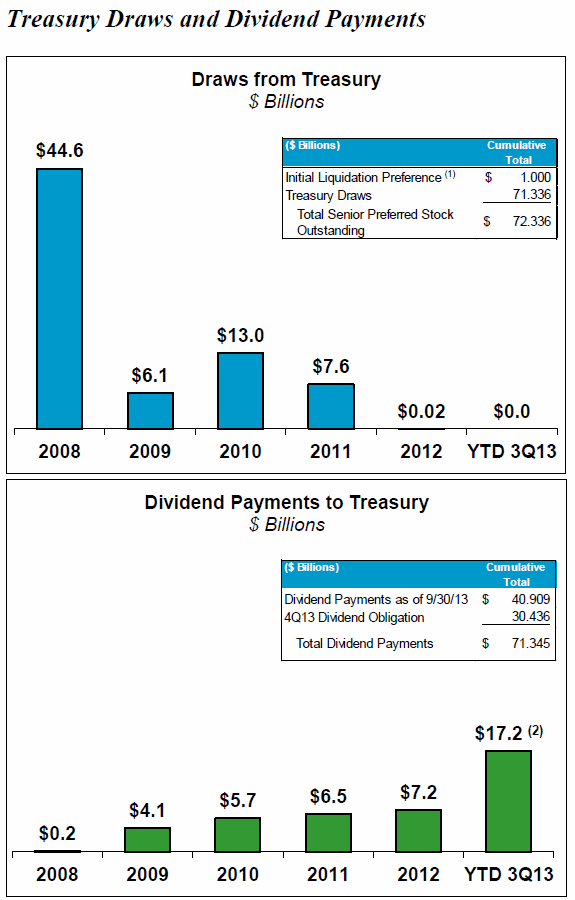
The $1.6 billion increase in pre-tax income primarily reflects higher other non-interest income driven by gains on securities and on multifamily mortgage loans as well as settlement proceeds from private label securities litigation. These numbers were partially offset by third quarter derivative losses of $0.1 billion compared to $1.4 billion in gains in Q2.
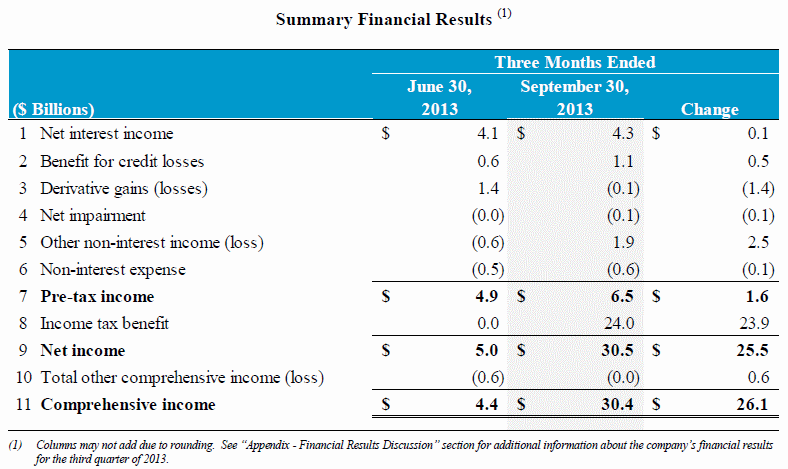
In addition to the tax benefits from the release of the deferred tax asset valuation allowance, the increase in comprehensive income came from higher net quarter income from improved fair values on the company's agency and non-agency available-for-sale (AFS) securities.
Despite its recent string of positive results the company cautions the level of these earnings in recent periods is not sustainable over the long term. Its financials have benefited from strong home-price appreciation which is expected to moderate, and have also included benefits from settlements of litigation with private label securities and repurchase claims. Also the mandated shrinkage of its mortgage related investment portfolio will reduce earnings over time.
Freddie Mac reported that the credit quality of its portfolio continued to grow as the share of that portfolio consisting of legacy loans decreased. The post-2008 book of business grew to 52 percent of the single-family credit guarantee portfolio during the third quarter excluding relief refinances which increased to 21 percent. Loans originated in 2005 through 2008 account for the majority of the $73 billion in provision for credit losses the company has recorded since the beginning of 2008 and these continue to represent a declining portion of the company's single-family credit guarantee portfolio.
The company completed approximately 128,000 workouts during the first nine months of 2013 including over 60,000 loan modifications. It has also continued to promote neighborhood stability by promoting sales of owned real estate (REO) to non-investors. Approximately 2/3 of REO sales since 2009 have been to owner occupants.
The serious delinquency rate among single family loans was 2.58 percent at the end of September compared to 2.79 percent at the end of June. While still abnormally high, the company says it compares favorably with the national rate of 5.88 percent reported by the Mortgage Bankers Association at the end of June. The multifamily delinquency rate (loans 60 days or more past due or in foreclosure) was 0.05 percent at the end of the third quarter compared to 0.09 percent at the end of the second.
Fannie Mae reported a quarterly profit in the third quarter of 2013 of $8.7 billion compared to $10.08 billion in the second quarter and $1.8 billion in the third quarter of 2013. Comprehensive income was $8.6 billion. Comprehensive income in the prior quarter was $10.25 billion and was $2.56 billion in the Q3 2012.
The company will pay $8.6 billion in dividends to the U.S. Treasury bringing its total payments during conservatorship to $114 billion. Senior preferred stock held by Treasury remained at $117.1 billion.
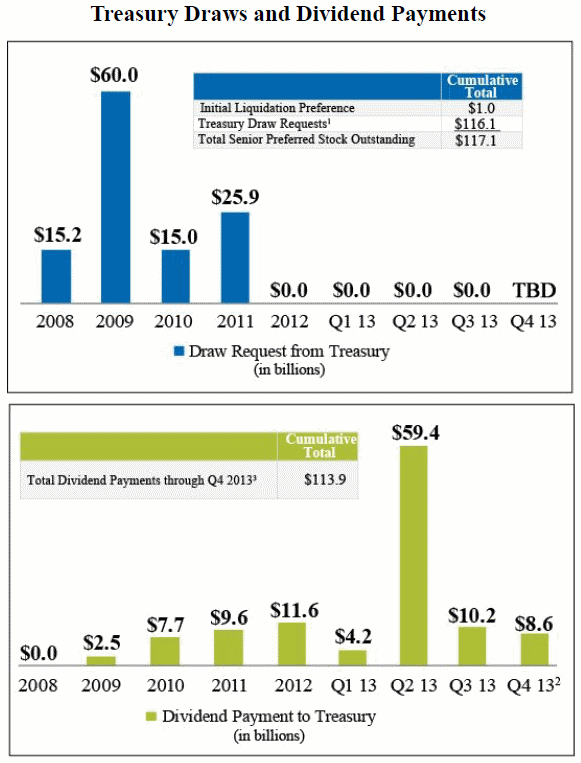
Fannie Mae said its strong quarterly results come primarily from continued stable revenues and credit-related income. Home prices increased during the quarter which resulted in a reduction of loss reserves recognition of fees received from Bank of America from a compensatory fee agreement also contributed to credit related income.
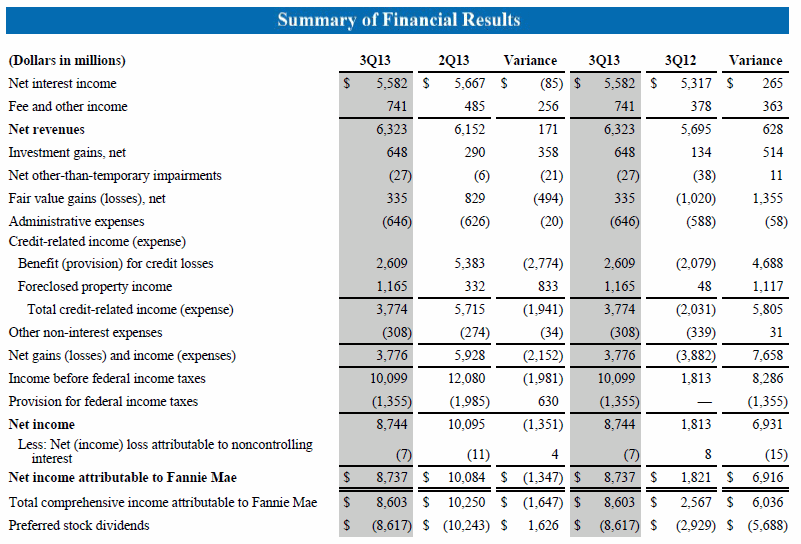
Fannie Mae continued to provide liquidity and stability in the mortgage markets. It remained the largest single issuer of single family mortgage-related securities in the third quarter with an estimated 48 percent share in the third quarter. During the second quarter, the last period for which information is available, it owned or guaranteed approximately 21 percent of the outstanding debt on multifamily properties.
The company says the quality loans acquired since 2009 continue to be strong. In the first nine months of 2013 single family conventional loans acquired by the company had a weighted average borrower FICO score of 754 and a weighted average loan to value ratio of 75 percent. Loans originated since 2009 now comprise 75 percent of Fannie Mae's single-family conventional guaranty book of business.
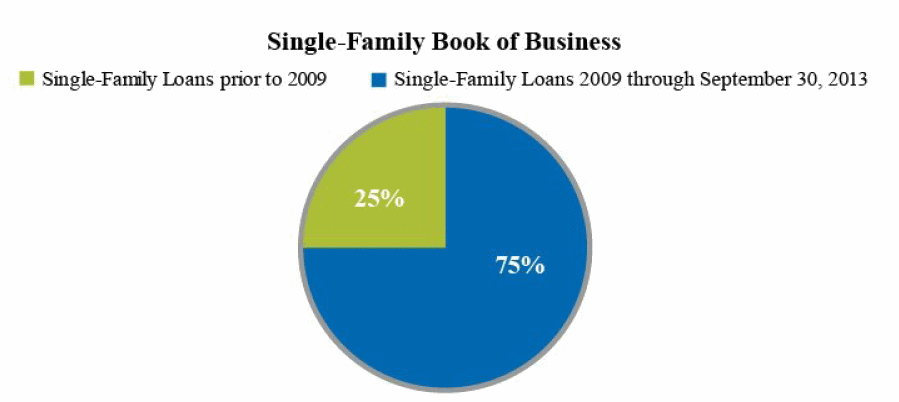
Fannie Mae's inventory of single-family foreclosed properties (REO) increased in the third quarter to 100,941 units compared to 96,920 units at the end of June. The company said that it both acquired more single family properties, 37,353 compared with 36,106 in the second quarter but saw dispositions of REO slow. The carrying value of the REO portfolio was $10.0 billion at the end of the quarter. The company's single family foreclosure rate, that is the annualized total number of properties acquired through foreclosure or deeds-in-lieu as a percentage of loans in its guaranty book of business, was 0.85 percent for the first nine months of 2013.







